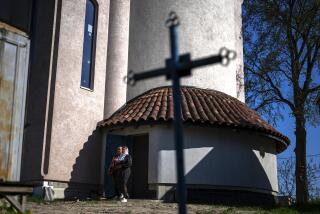Aging Church Looks to Its Roots for Renewal
HANOVER, Ind. — They came to church every other Sunday, four ladies perched like bookends in the wooden pews. They stayed even when the roof leaked, the plumbing didn’t work--and no one else was there.
This was the place where they had exchanged wedding vows, baptized children, celebrated Easter. This was their house of worship, but over the years it had become so much more.
So when St. Stephen’s African Methodist Episcopal Church began crumbling, when old folks died and young ones moved away, the ladies--all past age 65--held on. Decade after decade, as their gait slowed, as their eyesight dimmed, they came to pray.
But no church can stay alive with just four members. So when word came from the minister last year that St. Stephen’s--a 95-year-old building founded by descendants of slaves--couldn’t go on this way much longer, it seemed a piece of history was about to fall.
That’s when a younger woman from another church stepped in.
Sue Livers, 49, who grew up in this Ohio River town, joined the ladies to save St. Stephen’s. It was her tribute to a generation of women who had raised families even as they scrubbed floors as maids, raised other people’s children and survived the indignities of segregated schools, movie houses and lunch counters.
She knew what the church meant to them.
“This is where you came to be rejuvenated,” she says. “When nobody else wanted you, when you couldn’t go to the store, when you had to ride at the back of the bus, when you had to walk because there wasn’t a cab for you and the schools didn’t want you, you knew your church was your home. It was your sanctuary.”
Or as Miss Josephine Whittaker, the 84-year-old great-grandmother and backbone of the church, summed it up before her death Feb. 8:
“It’s like your right arm.”
To stay open, St. Stephen’s needs dollars and members--not many of either, but enough to restore the white, wood-frame church, pay assessments and the preacher, who now volunteers his services, and fill 16 whitewashed pews.
So far, more than $21,000 has been raised of the nearly $57,000 that architects estimate it will take to repair just the outside of the sagging building.
The church, though, needs a total face-lift. The paint is peeling, part of the rotting roof is covered with a blue plastic tarp, there is no water or bathroom, the pale-green ceiling is stained brown from water leaks, the piano is out of tune.
But on the back wall is a faded sign: “God Answers Prayers.” And hope always has prevailed here.
In its glory days, St. Stephen’s was a gathering spot for the town’s small black community. Prayer groups met, children clustered in the Sunday school and young women could eye the pool of potential husbands when they dished out homemade ice cream and blackberry cobbler from picnic tables on the lawn during August “homecomings.”
For the ladies, life’s biggest celebrations revolved around St. Stephen’s.
Miss Josephine came here first as a little girl, when Model Ts and horse-drawn buggies traveled along muddy roads and church ladies carrying towels escorted her through the winding hills to be baptized in the chilly waters of the Ohio.
She was married in the church in 1942, decked out that day in pink and navy. She taught Sunday school, as had her mother, Miss Jane. “Miss” is a term of respect still used around here.
Until she became too ill, Miss Josephine would pad across the street from her house every other Sunday morning, unlock the door, turn on the heat and prepare for Communion, pouring homemade wine into tiny plastic glasses.
Then she’d wait to greet the minister, imported from a nearby town. When the other ladies arrived, they’d all take their favorite seats--at each end of two pews.
“Without the church, I don’t think you’d have too much,” Miss Josephine said weeks before she died, her voice decimated by chemotherapy to a ragged rasp. “It was something to do. It was the right thing to do.”
She was thinking of St. Stephen’s, too, in her final days, telling Mrs. Livers in their last conversation: “I don’t want the church to go to ruins. I want to make sure that you keep it going.”
Davidteen Watson, 66, shares her loyalty, having attended the church since her parents brought her here as a child. One Sunday nearly a half century ago, she and her husband-to-be, Leon, who was heading off to the Korean War, walked down the narrow aisle, interrupted the sermon and asked to be married. They were. Then the service continued.
It seemed nothing could stop the church, not even a cross burning on the lawn outside remembered by Miss Leatha Davis, who was baptized, married and raised four children there.
Miss Leatha, who at 85 still rises before dawn to bake fruit pies, dug plumbing lines for St. Stephen’s. Her father, the son of slaves, and her husband helped put up the building, nailing together lumber salvaged from a nearby church.
St. Stephen’s is in Jefferson County, an area linked to one of the major routes of the Underground Railroad, the secret movement that helped Southern slaves escape to the free North.
Mrs. Livers hopes the church’s historical links will help earn it a spot on the registry of national landmarks.
And Anna Davis Jones, the fourth member of the church and Miss Leatha’s 68-year-old stepdaughter, says preserving the past and passing on a legacy is what this rescue mission is all about.
“This is for the young people,” she says. “They need to know how the older people paved the way so they could have a place to worship.”
No one appreciates their devotion more than Pastor Leonard Miles Sr., who has ministered to the ladies for about four years, driving 66 miles every other Sunday to preach. The alternate-week services are due to the small membership.
Miles also throws $40 of his own money into the collection plate at the end of each sermon to help the ladies, who have, on a few occasions, dug into their own pocketbooks to pay the church’s water or electricity bills.
“There’s a bond between them and me,” he says, standing at the pulpit as the worshipers arrive. “I love them.”
But he knows St. Stephen’s can’t survive on the shoulders of a few determined widows. “It’s going to take other people to have the same desires they have,” he says.
And that word has spread.
One recent Sunday, nearly two dozen folks worshiped at St. Stephen’s, including some of the ladies’ grandchildren and great-grandchildren. Some old-timers also have returned, including Estelle Holloway, a 71-year-old retired teacher, who sang hymns with her husband, Clem, from worn red leather Bibles in the same room in which they were wed.
After more than 30 years away, they heard about the church’s predicament and now drive three hours round trip from their Louisville, Ky., home for services.
“The church back then was the only place we could go to enjoy ourselves . . . the only place where we could feel safe and free,” she says wistfully. “It feels great to be back. Was it Thomas Wolfe who said you can’t go home again? Well, I feel like I can.”
More to Read
Sign up for Essential California
The most important California stories and recommendations in your inbox every morning.
You may occasionally receive promotional content from the Los Angeles Times.










